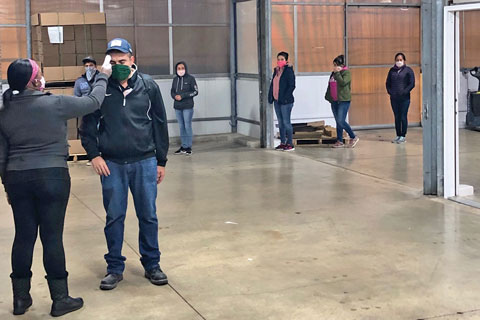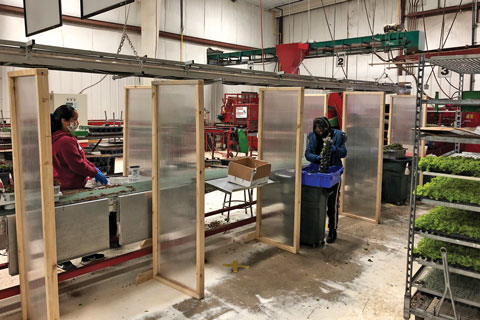6/1/2020
Greenhouse Safety in a Pandemic & Post-COVID World
Bill Calkins

Greenhouses across the U.S. and Canada have been busy this spring, and that’s probably an understatement. Garden centers and online sales have been excellent and it’s clear #springisnotcancelled and #gardeningisessential has helped.
Pictured: As workers begin shifts at Four Star, nurses are on hand to check temperatures and assess overall health.
Shipping plants and filling orders have kept greenhouses running a mile a minute, but there’s another major consideration keeping many owners and managers up at night—worker safety. While many businesses have closed physical doors and encouraged remote work during the coronavirus pandemic, most greenhouses have remained open and operational. As an industry, we’re thankful for our “essential” status, but also must put new processes and protocols in place to minimize disease risk for all team members and reduce the spread of sickness for workers on the job.
GrowerTalks virtually sat down with Abe VanWingerden, president of Metrolina Greenhouses in Huntersville, North Carolina, and Jeff Back, head of greenhouse operations at Four Star Greenhouse in Carleton, Michigan, to discuss what these two operations are doing to keep their entire staff safe and healthy during the coronavirus pandemic.
Cleaning & sanitation
The first steps suggested for any manufacturing business, greenhouses included, are related to cleaning. A full deep-clean of all facilities assures you’re starting from a safe baseline. Hiring a professional crew is recommended, or asking your current cleaning company to bring on some additional help to make sure every area is cleaned and disinfected to the best of their ability.
From this point forward, increased attention must be paid to daily and weekly cleaning. This is not “business as usual.” Areas to focus on include interior and exterior doors, desks, carts, greenhouse equipment, telephones, computer or machine keyboards and warehouse equipment. And no doubt you’ll come across many other areas that might not have been expected. Every greenhouse is different, so keep an eye out for hot spots.
Four Star uses a labeling system to mark what they call “touchpoints”—high-risk or often-used areas and equipment. They mark them with a yellow dot to not only remind the cleaning crews to disinfect regularly, but to also call attention to these areas for workers.
“We put these yellow dots on micro-waves and other areas to help people think about it,” Jeff says. “We also have a crew of between six and eight going through and all they do is clean.”
Metrolina has been using a 3% bleach solution recommended by the Centers for Disease Control (CDC), and every night, crews are spraying down breakrooms, people-movers, electric carts and other equipment and common areas.
“We have a separate crew that does this,” Abe explains. “Don’t assign this to the guys spacing plants and ask them to clean at the end of the day because it won’t get done.”
Once facilities are clean, institute a handwashing or hand-sanitizing policy for employees. Have plenty of sanitizer on hand and place it in areas that will remind workers to stay on top of personal cleanliness. And don’t neglect personal items that are touched throughout the day, such as phones.
Protecting people
Both Four Star and Metrolina are encouraging workers to wear facemasks at work. The CDC has advised that the virus can spread between people interacting in close proximity—for example, speaking, coughing or sneezing—even if those people aren’t exhibiting symptoms. Because of this, cloth face coverings are recommended in public settings where other social distancing measures are difficult to maintain, like many greenhouse areas.
“We gave everyone two bandanas early on after one of our employees recommended it,” Abe says. “I would guess 60% or 70% of our employees are wearing them now when they’re in close proximity to others.”
Metrolina will only require masks if they see lower adoption or if the city, county or state requires it in the workplace, he adds.
Both companies have an internal training video system in place to share best practices with all employees and are posting signage throughout the greenhouses and in breakrooms to help workers understand and follow guidelines.
 Another way to reduce the risk of disease in greenhouses is to monitor employee health. At Four Star, management has health and wellness top of mind and this comes from an ownership mantra.
Another way to reduce the risk of disease in greenhouses is to monitor employee health. At Four Star, management has health and wellness top of mind and this comes from an ownership mantra.
“Our owners, Tom and Sharon Smith, wanted workers to feel safer here than anywhere else,” Jeff says. “And this was a challenge to the management staff.”
Pictured: When social distancing is difficult, consider plexiglass barriers to keep workers safe in congested areas, such as this production line at Four Star Greenhouse.
They suggested bringing in nurses to check temperatures and do anything possible to make people feel comfortable, he says. Now, when workers report to the greenhouses, a nurse scans them with a temporal thermometer and alerts management if anyone shows a fever. Jeff says the nurse stays around for the first couple hours of each shift and walks around to each worker as a resource to talk to, adding reassurance that the company is going above and beyond to make sure everybody is safe.
Abe adds that they want workers to feel safer when they leave the greenhouse than when they came in.
“People at home are nervous that family members are going to work and what they might bring home,” he says. “In an environment like ours, we need to provide a safe working place.”
All crew leaders ask workers five questions in morning meetings to assess general health, and if the workers answer “yes” to any of these questions or look ill, they’re sent to Human Resources where they go through a temperature and health screen. Sick workers are sent home, Abe says.
Greenhouse-specific protocols
Greenhouses are open spaces by nature, but some areas can become quite congested, especially in busy times. From talking with Abe and Jeff, production areas might be easier to manage distancing than common areas, time clocks and other pinch points, but still require consideration.
“On a production line, you can physically spread people out and know the space you’re confined in and really measure it out,” Abe says. “It’s actually more difficult in the shipping portion of the greenhouse where you don’t have a standardized way of doing work.”
In those areas, a crew of six handling 60 carts won’t all touch each cart under current conditions—each person would now handle 10 carts, he explains.
Greenhouses are also learning from the manufacturing sector and staggering or splitting shifts to create space for workers. And when strategies like this are maxed out, there’s always plexiglass barriers like we’re all seeing at retail.
“We are marking off spaces on the floor to distance people,” Jeff says. “And where we can’t, we’re adding barriers because we need more people on some lines than we have space for.”
And at Four Star, they checked with the workers before adding barriers, he explains. Making sure processes don’t inhibit what the crews do is advised—even things like the ability to make eye contact or talk with each other.
One specific challenge was eliminating the need for two people to walk side by side down corridors pulling long chains of carts. Jeff explains they now have a person in front pulling and one in back pushing, just to create the appropriate social distance.
Increased efficiency?
Believe it or not, changing some of the processes as described above has actually resulted in some measured benefits, according to Abe.
“Instead of one person picking up a tray and handing it to another person who hands it to another person to put on a cart, one person pick up the tray and puts it onto the cart,” he explains. “I know it sounds simple, but we were amazed how many multiple handles we’d created in our processes that are now eliminated.”
And spreading people out on the production line allows people to focus on their job more, he adds. In many areas, there’s only so far you can spread out, so both operations are learning how to alternate crews on both sides of the line to create space.
Abe goes on to say that no matter when a business implements changes, they need to measure the effects. And in the current situation, the data is beginning to show that slowing things down has resulted in better and more accurate throughput. So don’t just make changes on the fly and wait for the pandemic to end so your business can get back to normal; look at the changes and determine which ones should become a part of the process as we begin to normalize.
Looking forward
Before wrapping up the conversation, Abe and Jeff weighed in on what many of these COVID-related changes and considerations mean moving forward and how the current state might impact the future of greenhouse production in North America and around the world. In a nutshell, both felt that many of the new practices will remain once the current threat has passed.
According to Abe, many of the sanitation protocols will become normalized and how Metrolina operates in the future, both in terms of production and how the greenhouse business operates.
“For example, we learned that by staggering breaks and lunches, we don’t need as many microwaves, and bathrooms don’t need to be as large,” he says. “There are costs that you don’t even think about when you have the old-school ‘everybody has to go to break and lunch at the same time’ mentality.”
When you stagger shifts, you can create efficiencies just by getting people out of the way for work that needs to get done, he adds.
And the cleanliness guidelines are just logical, Abe feels. In a production greenhouse, no one had ever really thought about them. But now and in the future, they’ll be much more top of mind. And when attracting people to work at your facilities, they’ll now look at your sanitation and cleanliness standards.
“It’s a thing now,” he says. “And we have to be ready for it.”
“We’ve talked about it [at Four Star] and there’s really nothing we’ve done or added that we’ll turn back from,” Jeff says. “There’s a lot to be said for keeping people happy and healthy.”
Michigan has a big cold and flu season, and if they can impact attendance rates and improve worker health, that goes a long way, he explained.
If you found this article helpful and would like to hear the full discussion with Abe and Jeff, you’re in luck! We have the full recorded interview, with video, available on the GrowerTalks YouTube channel at youtube.com/growertalks.
And for a slideshow covering many of the best practices shared in this story, plus more, check out slideshare.net/bcalkins/developing-guidelines-in-a-pandemic-postcovid-greenhouse-world.
Lastly, for constantly updated COVID-19 News & Updates from GrowerTalks, be sure to bookmark our COVID-19 Resource Page: growertalks.com/COVID-19. GT